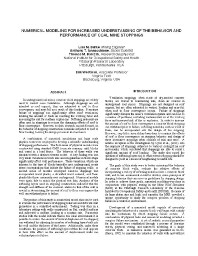Mining Publication: Numerical Modeling for Increased Understanding of the Behavior and Performance of Coal Mine Stoppings
Original creation date: August 2004
Authors: LM Burke, AT Iannacchione, TM Barczak, EC Westman
NIOSHTIC2 Number: 20025352
In: Peng SS, Mark C, Finfinger GL, Tadolini SC, Heasley KA, Khair AW, eds. Proceedings of the 23rd International Conference on Ground Control in Mining (August 3-5, 2004). Morgantown, WV: West Virginia University, 2004; :112-118
In underground coal mines, concrete block stoppings are widely used to control mine ventilation. Although stoppings are not intended as roof support, they are subjected to roof-to-floor convergence and may fail as a result of this loading. Premature failure of stoppings can significantly affect mine ventilation, limiting the amount of fresh air reaching the working faces and increasing the risk for methane explosions. Softening materials are often used in stoppings to reduce the damaging effects of roof-to-floor convergence. However, research to date has not focused on the behavior of stopping construction materials subjected to roof or floor loading, leaving the design process to trial and error. A combination of numerical simulations and large-scale physical tests were used to develop a scientific understanding of stopping performance. The first series of physical models was constructed using standard concrete masonry unit blocks and tested in a load frame. The behavior of these walls was simulated with a distinct-element model. A key finding was that very small variations in block size and irregularities in block shape significantly affect wall performance. These variations, which are inherent to the type of blocks typically used underground, create stress concentrations that initiate the failure of stopping walls. A second series of models used concrete stoppings that incorporated wood planks, a shredded wood material, and foam planks like those commonly used underground. Numerical models were again able to match the physical test data. Analysis of the softening layers used in stopping construction indicated that the strength and stiffness of the material relative to that of the wall is crucial in determining the amount of roof-to-floor convergence that the wall can withstand prior to failure. The product of this study is a numerical model that can be used to evaluate the performance of stopping materials and different wall geometries in a controlled environment. Testing was done in a lab setting with walls constructed on flat, parallel surfaces and subjected to uniform loading at a constant rate. Parametric studies with the model indicate that in this ideal environment it is possible to control the amount of vertical displacement that the stopping can withstand by adjusting the number of softening layers built into the wall and the thickness of the layers. In addition, under these conditions, the position of softening layers within the wall seems to have little effect on the amount of displacement that walls can withstand prior to failure.

NIOSHTIC2 Number: 20025352
In: Peng SS, Mark C, Finfinger GL, Tadolini SC, Heasley KA, Khair AW, eds. Proceedings of the 23rd International Conference on Ground Control in Mining (August 3-5, 2004). Morgantown, WV: West Virginia University, 2004; :112-118
- Coal Bumps and Odd Dynamic Phenomena - A Numerical Investigation
- Development of Guidelines for the Design of Support Systems to Manage Coal Mine Rib Hazards
- Diagnosing and Controlling Moisture-Sensitive Roof in Coal Mines
- Effect of Longwall Face Advance on Spontaneous Heating in Longwall Gob Areas
- Elastic and Shear Moduli of Coal Measure Rocks Derived from Basic Well Logs Using Fractal Statistics and Radial Basis Functions
- Numerical Modeling Procedures for Practical Coal Mine Design
- Performance Characteristics for Welded Wire Screen Used for Surface Control in Underground Coal Mines
- Propagation of UHF Radio Waves in Limestone Room and Pillar Mines
- Stochastic Modeling of Gob Gas Venthole Production Performances in Active and Completed Longwall Panels of Coal Mines
- Support Design Procedures for Difficult Ground Conditions